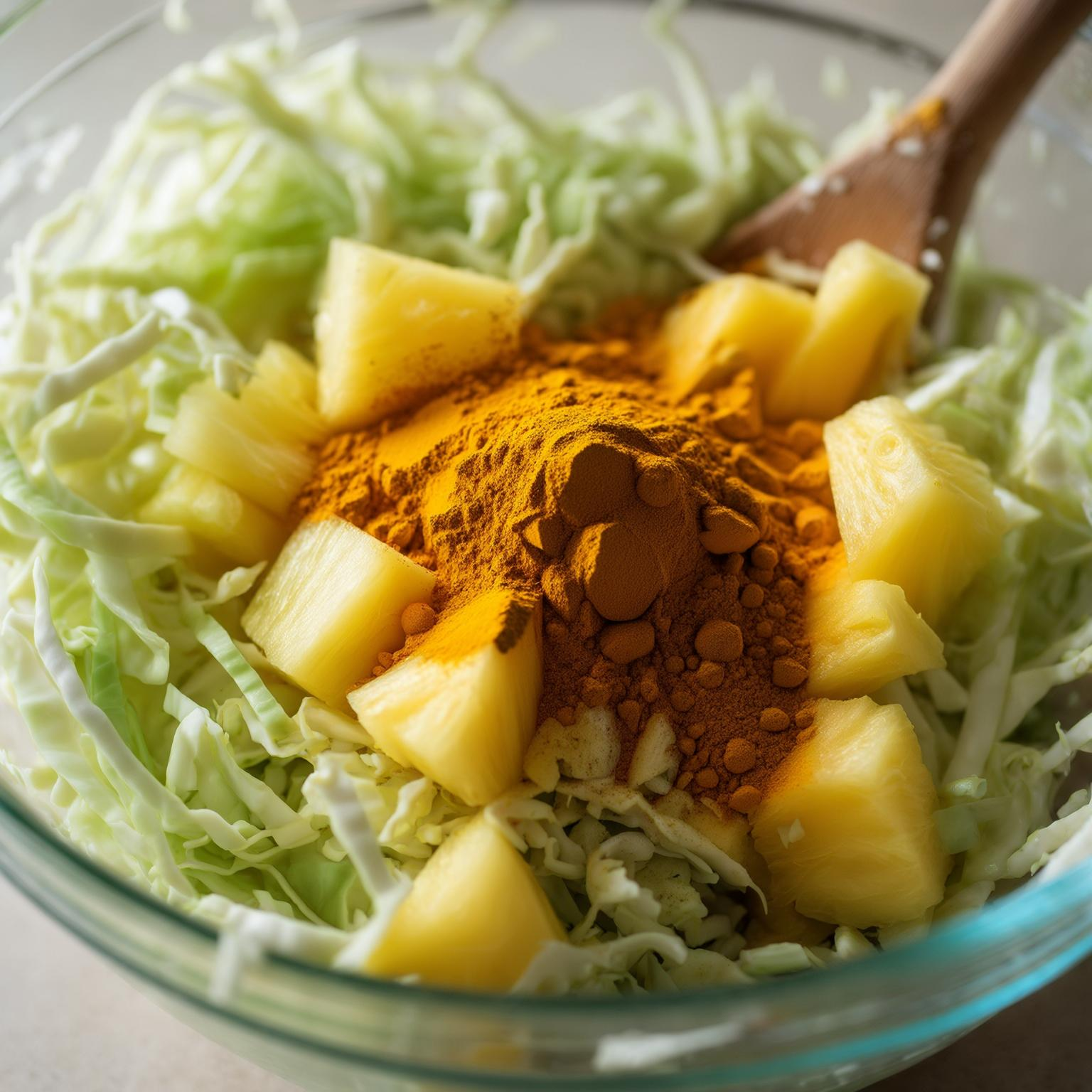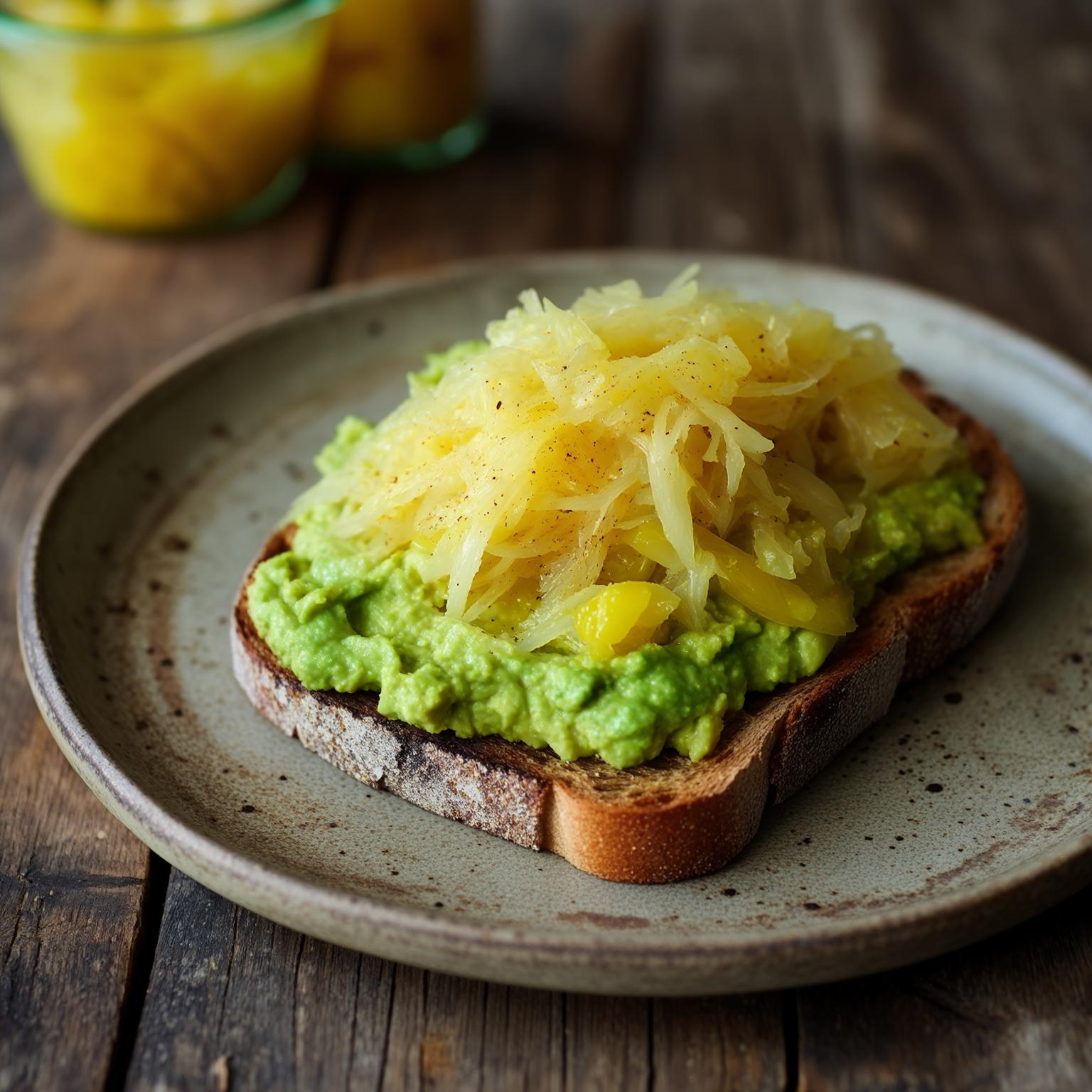Introduction
Pineapple Turmeric Sauerkraut is more than a tangy, vibrant side dish—it’s a reflection of my culinary journey and my belief in the healing power of food. I’m Emily Harper, the heart behind BrekCakes, a chef, writer, and former journalist who swapped breaking news for breaking bread.
Growing up in a small Vermont town, I learned early on that the best recipes weren’t just about ingredients—they were about stories, memories, and connection. Years later, in my Portland bistro and through this blog, I’ve continued that tradition, creating dishes that bring people together and nourish body and soul.
This sauerkraut recipe is one of those dishes. Born out of a love for functional ingredients and fermentation, it combines sweet pineapple, earthy turmeric, and crunchy cabbage with a splash of raw apple cider vinegar. It’s a probiotic powerhouse that supports digestion, reduces inflammation, and lights up your taste buds.
Whether you’re a seasoned fermenter or a curious first-timer, you’ll find everything here—from the science behind the ferment to troubleshooting tips and tasty serving ideas. And if you love flavorful, health-forward recipes, don’t miss our zucchini breadwich for another twist on wholesome comfort food.
Let’s dive into why this golden kraut is worth a place in your fridge—and on your plate.
Print
Pineapple Turmeric Sauerkraut
- Total Time: 10 days
- Yield: 1 half-gallon 1x
Ingredients
-
1 Head Green Cabbage, shredded
-
½ Pineapple, diced
-
1 Tbsp Fresh Ginger
-
1 Tbsp Sea Salt (kraut)
-
1 Tbsp Turmeric Powder
-
Brine: 1 Tbsp Sea Salt, 1 Tbsp Raw Apple Cider Vinegar, 4 cups Spring Water
Instructions
-
Mix cabbage, pineapple, ginger, and salt. Let rest.
-
Make brine. Add turmeric and combine.
-
Pack into jars and pour brine over.
-
Loosen lid for fermentation gases.
-
Shake daily. After 7–10 days, refrigerate.
-
Serve chilled. Enjoy extra brine as a probiotic tonic.
- Prep Time: 45
- Cook Time: 7–10 days
Nutrition
- Serving Size: 2 tablespoons (30g)
- Calories: 12
- Sugar: 1.5g
- Sodium: 220mg
- Fat: 0g
- Saturated Fat: 0g
- Unsaturated Fat: 0g
- Trans Fat: 0g
- Carbohydrates: 2.5g
- Fiber: 1g
- Protein: 0.5g
- Cholesterol: 0mg
Introduction to Pineapple Turmeric Sauerkraut
What is Pineapple Turmeric Sauerkraut?
Pineapple Turmeric Sauerkraut is a fermented cabbage dish infused with tropical pineapple, warm turmeric, and ginger. It’s made by packing shredded cabbage and pineapple into jars with a brine of sea salt, apple cider vinegar, and water. Over time, natural bacteria ferment the mixture, turning it into a tangy, probiotic-rich superfood.
What makes it unique is the flavor profile—it balances the savory crunch of traditional sauerkraut with the sweetness of pineapple and the earthy spice of turmeric. Plus, the vibrant yellow hue is a showstopper on any plate.
The Rise of Functional Fermented Foods
Fermented foods have been gaining traction for their gut-boosting benefits. But this kraut isn’t just another health trend—it’s functional food done right. Combining turmeric’s anti-inflammatory magic with pineapple’s digestive enzymes and the natural probiotics of lacto-fermentation, it’s a triple-threat for wellness seekers.
From kombucha to kefir, fermentation is making a comeback. And in this sea of sour sips and pickled bites, Pineapple Turmeric Sauerkraut offers a refreshing, crunchy, and brightly flavored alternative you can make at home.
Don’t miss our lemon dump cake with poppy seeds if you’re into flavor fusions that surprise and delight.
Why Pineapple and Turmeric Are a Powerful Combo
What Do Turmeric and Pineapple Do for the Body?
The real magic of Pineapple Turmeric Sauerkraut lies in its two hero ingredients—pineapple and turmeric. Each brings unique healing benefits to the table, and when combined, they amplify each other’s effects in powerful ways.
Pineapple is more than just tropical sweetness. It contains bromelain, a digestive enzyme that helps break down proteins and ease bloating. It’s also loaded with vitamin C, which supports your immune system, and antioxidants that fight off oxidative stress. In traditional wellness circles, pineapple is often used to soothe inflammation and speed up recovery from workouts or illness.
Turmeric, on the other hand, is best known for curcumin, the compound responsible for its signature golden hue and impressive health benefits. Curcumin is a potent anti-inflammatory and antioxidant. It helps calm chronic inflammation—a root cause of many modern diseases, including heart disease, diabetes, and arthritis. Studies also suggest curcumin supports brain function, balances mood, and protects against cognitive decline.
When you ferment these two together, their powers multiply. Fermentation enhances the bioavailability of curcumin, making it easier for your body to absorb. Plus, the probiotic action of the kraut improves gut health, which is directly linked to your immune system, mental health, and more.
Looking for inspiration? Try our cottage cheese ice cream for another gut-friendly treat with a surprising twist.
Key Nutrients and Anti-Inflammatory Benefits
Let’s break it down:
| Ingredient | Star Compound | Benefit |
|---|---|---|
| Pineapple | Bromelain, Vitamin C | Aids digestion, supports immunity |
| Turmeric | Curcumin | Fights inflammation, protects brain |
| Ginger | Gingerol | Eases nausea, supports metabolism |
| Cabbage | Fiber, Vitamin K | Supports gut health, anti-cancer properties |
This combination isn’t just about good flavor—it’s functional nourishment with real benefits you’ll feel. By adding just a few spoonfuls of Pineapple Turmeric Sauerkraut to your daily meals, you’re giving your body a natural, flavorful boost.
Fermented foods like this don’t have to be intimidating. They can be vibrant, simple, and satisfying. Don’t miss our trader joe’s lobster pasta for more unique flavor pairings that break the mold.
Health Benefits of Fermented Sauerkraut
Is Pineapple Turmeric Sauerkraut Good for You?
Yes—Pineapple Turmeric Sauerkraut is incredibly good for you, thanks to its powerhouse blend of fermented cabbage, golden turmeric, and tropical pineapple. This vibrant, probiotic-rich kraut supports everything from digestion to inflammation to immunity—and it tastes amazing too.
Fermentation gives this sauerkraut its superfood status. The process naturally creates probiotics, the good bacteria that improve gut health and overall wellness. These microbes help balance your digestive system, ease bloating, improve nutrient absorption, and even support mental clarity and mood—because a healthy gut means a healthier you.
Add in the anti-inflammatory properties of turmeric and the digestive enzymes from pineapple, and Pineapple Turmeric Sauerkraut becomes more than a side dish—it becomes a daily ritual for feeling your best.
Digestive, Immune, and Anti-Inflammatory Support
The ingredients in Pineapple Turmeric Sauerkraut are carefully chosen for function as much as flavor. Let’s break it down:
| Ingredient | Benefit |
|---|---|
| Cabbage | Packed with fiber, supports gut and liver detox |
| Pineapple | Contains bromelain to aid digestion and reduce swelling |
| Turmeric | Loaded with curcumin, which helps fight inflammation |
| Ginger | Soothes the digestive tract and supports metabolism |
| Apple Cider Vinegar | Promotes good gut bacteria and balances pH levels |
Eating a few spoonfuls of Pineapple Turmeric Sauerkraut each day is a natural way to flood your body with beneficial nutrients and enzymes. It’s low-calorie, gut-friendly, and 100% plant-based.
Want a creative pairing? Don’t miss our zucchini breadwich—stack it with this kraut for a fiber-packed, gut-loving combo.
How to Make Pineapple Turmeric Sauerkraut at Home
Ingredient Breakdown: Nutrient Roles
Making your own Pineapple Turmeric Sauerkraut is not only simple—it’s deeply satisfying. With just a few vibrant ingredients, you can craft a gut-friendly ferment that’s as nutritious as it is delicious.

Here’s what you’ll need, and what each ingredient brings to the table:
| Ingredient | Nutritional Role |
|---|---|
| Green Cabbage (1 head, shredded) | High in fiber, vitamin C, and natural prebiotics |
| Pineapple (½, diced) | Contains bromelain for digestion, adds natural sweetness |
| Fresh Ginger (1 Tbsp, minced) | Anti-inflammatory, aids nausea relief and digestion |
| Sea Salt (2 Tbsp total) | Essential for brine formation and fermentation control |
| Organic Turmeric Powder (1 Tbsp) | Curcumin-rich, supports immune health |
| Raw Apple Cider Vinegar (1 Tbsp) | Balances pH, enhances gut flora |
| Spring Water (4 cups) | Clean base for the brine, free from chlorine and chemicals |
These ingredients aren’t just flavorful—they work together to turn humble cabbage into a jar of probiotic gold.
Step-by-Step Instructions with Pro Tips
Here’s how to turn these raw components into your own batch of Pineapple Turmeric Sauerkraut:
- Prep the Produce
Shred one head of green cabbage finely. Dice ½ of a fresh, ripe pineapple into ½-inch chunks. Add both to a large mixing bowl. - Add Ginger and Salt
Sprinkle in 1 Tbsp of sea salt and 1 Tbsp of minced fresh ginger. Mix with your hands for 1–2 minutes to release moisture from the cabbage. Let rest for 20–30 minutes to draw out more brine naturally. - Make the Probiotic Brine
In a separate container, dissolve 1 Tbsp of sea salt in 1 cup of hot spring water. Then add 3 cups of cool spring water and 1 Tbsp of raw apple cider vinegar. Stir well. - Add Turmeric
Toss in 1 Tbsp of turmeric powder. Using tongs (to avoid stained hands), mix it thoroughly with the cabbage and pineapple mixture. - Pack into Jars
Use a half-gallon mason jar or two quart-size jars. Fill each jar halfway with the kraut mixture, then pour the brine over until everything is submerged—leave about 1 inch of space at the top. Screw on the lids tightly. - Ferment Properly
Loosen the lid slightly to allow gases to escape. Store the jars in a cool, shaded area (around 65–72°F) and shake gently once daily. Check that all contents stay submerged under brine to avoid mold. - Monitor and Maintain
Over the next 5–10 days, your kraut will bubble, cloud slightly, and develop flavor. Skim off any harmless “scum” that forms on the surface. After about a week, taste test. Once it reaches your desired sourness, refrigerate. - Enjoy & Store
Your Pineapple Turmeric Sauerkraut is now ready! Keep it refrigerated for up to 3 months. The flavor will continue to develop beautifully over time.
Pro Tip: Don’t toss the leftover brine—sip it as a probiotic tonic, or use it as a starter for your next batch!
If you love creating vibrant, nutrient-packed dishes like this, you’ll also enjoy our lemon dump cake with poppy seeds—a zesty treat with a twist of wellness.
Perfecting the Taste of Pineapple Turmeric Sauerkraut
What Can Be Added to Sauerkraut to Make It Taste Better?
Even though Pineapple Turmeric Sauerkraut already has a bold and bright flavor profile, there’s always room to level it up. Whether you prefer it zesty, spicy, or savory, the base recipe is super versatile and open to your creativity.
Here are some popular and flavorful add-ins that blend beautifully with this golden kraut:
| Ingredient | Flavor Boost | Function |
|---|---|---|
| Garlic cloves | Pungent, earthy | Adds umami and antimicrobial benefits |
| Red pepper flakes or sliced chili | Spicy kick | Enhances metabolism and warmth |
| Carrots (shredded) | Natural sweetness | Boosts crunch and color |
| Golden raisins or cranberries | Sweet-tart contrast | Balances savory and sour notes |
| Cumin seeds or coriander | Earthy depth | Adds aromatic spice |
| Fresh herbs (dill, cilantro, parsley) | Fresh finish | Enhances complexity post-fermentation |
Keep in mind, if you’re adding fresh herbs or fruits like raisins, it’s best to add them toward the end of fermentation or even after refrigerating to avoid unwanted bacterial overgrowth or spoilage.
Flavor Boosters: Garlic, Chili, Herbs, and More
Let’s say you want your Pineapple Turmeric Sauerkraut to have more bite—toss in chopped garlic and a bit of red chili during the brining stage. This not only brings heat but deepens the overall flavor without overpowering the sweetness of pineapple.
If you’re going for a mild, aromatic finish, a pinch of ground cumin or coriander seed can introduce earthy undertones that pair beautifully with turmeric. For those craving a crunchier bite, carrot ribbons not only complement the texture but add beta carotene and extra fiber.
After fermentation, sprinkling in fresh chopped cilantro or parsley gives the kraut a final flavor burst—and visual appeal.
Don’t forget, experimentation is the heart of homemade fermentation. One of the joys of making your own sauerkraut is that you get to customize the taste, texture, and spice to your exact liking.
Looking for a unique dessert to follow your tangy kraut dish? Don’t miss our cottage cheese ice cream—a creamy, high-protein surprise that balances savory meals with a clean finish.

Fermentation Science Explained Simply
How Fermentation Works
At the heart of Pineapple Turmeric Sauerkraut is a fascinating biological process: lacto-fermentation. This natural method uses lactic acid bacteria, particularly Lactobacillus, to convert sugars in cabbage and pineapple into lactic acid. This acidic environment not only preserves the kraut but also transforms it into a probiotic powerhouse.
Here’s what happens step-by-step:
- Anaerobic Environment: Packing your ingredients under brine removes oxygen, creating an anaerobic (oxygen-free) space that good bacteria love—and harmful bacteria hate.
- Lactic Acid Production: Natural bacteria on the cabbage and pineapple start to feed on sugars, producing lactic acid as a byproduct.
- pH Drop: The brine becomes more acidic over time, which further preserves the food and gives sauerkraut its signature tang.
- Probiotics Multiply: Beneficial microbes flourish, enriching your kraut with live cultures that support your gut.
What makes Pineapple Turmeric Sauerkraut unique is that turmeric and pineapple both offer additional prebiotic support—fuel for these probiotics—making it an even more effective digestive aid.
Why Brine, Salt, and Apple Cider Vinegar Matter
Every ingredient in this kraut’s fermentation process has a purpose:
- Sea Salt (1 Tbsp per quart): Draws moisture from the cabbage, inhibits bad bacteria, and regulates the speed of fermentation.
- Brine (Spring Water + Sea Salt + Vinegar): Provides an optimal environment for the fermentation to thrive while keeping everything safely submerged.
- Raw Apple Cider Vinegar: Contains “the mother,” rich in acetic acid and enzymes. It helps lower the pH of the brine early in the process, giving the good bacteria a head start.
Let’s look at the science behind this synergy:
| Component | Scientific Function |
|---|---|
| Salt | Dehydrates cabbage, suppresses spoilage microbes |
| Vinegar | Speeds up pH drop, boosts antimicrobial action |
| Spring Water | Avoids chlorine that could kill bacteria |
| Time | 5–10 days for optimal probiotic development |
The result? A delicious, crunchy, slightly sour kraut that’s alive with beneficial microbes. No pasteurization, no additives—just nature doing its work.
This process might sound technical, but it’s surprisingly foolproof. And once you’ve mastered this golden kraut, you’ll never want store-bought again.
Don’t miss our trader joe’s lobster pasta if you’re curious how to combine gourmet flavor with simplicity—just like this kraut.
Best Ways to Eat and Store Your Sauerkraut
Should You Rinse Sauerkraut Before Eating?
One of the most common questions I get about Pineapple Turmeric Sauerkraut is whether it should be rinsed before serving. The short answer? No, you shouldn’t rinse it—unless absolutely necessary.
Here’s why: rinsing sauerkraut washes away the live probiotics that develop during fermentation. These beneficial bacteria are what make this kraut so valuable for your gut health. Rinsing also removes much of the brine, which contains minerals, enzymes, and the sour-sweet balance that defines its flavor.
However, there are exceptions:
- If the kraut is too salty for your taste, a quick rinse may tone it down.
- If you’re cooking it into a hot dish (like stir-fry or soup), you can rinse and drain first—but you’ll lose the probiotic benefits due to heat anyway.
For the full health boost, always eat it raw and unrinsed—preferably chilled, straight from the jar.
Serving Suggestions and Storage Tips
Pineapple Turmeric Sauerkraut is incredibly versatile. Here are easy, delicious ways to enjoy it daily:
| Serving Idea | How to Use It |
|---|---|
| On avocado toast | Adds tang, texture, and anti-inflammatory benefits |
| With eggs | Serve alongside scrambled or hard-boiled eggs for a gut-boosting breakfast |
| In tacos or wraps | A juicy topping that balances spicy or smoky flavors |
| Over grain bowls | Mix into quinoa, rice, or farro with greens and beans |
| As a side | Add to any grilled protein or roasted veggie dish |
Need a detox shot? Sip a tablespoon or two of the leftover brine—it’s filled with enzymes and probiotics that support digestion and help reduce inflammation.
For storage:
- Refrigerate your sauerkraut once it’s fermented to your desired sourness.
- It’ll last for up to 3 months in the fridge, sometimes longer if stored properly.
- Always use a clean fork when serving to prevent contamination.
- If mold appears on the surface or the smell is off (think sulfuric or rotten), discard it.
If you love bright, wholesome recipes like this, don’t miss our lemon dump cake with poppy seeds—an easy dessert that packs flavor and flair into every bite.
Common Mistakes and Troubleshooting
Why Is My Pineapple Turmeric Sauerkraut Cloudy or Smelly?
Fermenting foods can feel mysterious, especially if you’re new to it. But most of the time, what looks or smells “off” is totally normal. Pineapple Turmeric Sauerkraut, with its vibrant color and tropical ingredients, might act a little different than traditional kraut—but that doesn’t mean it’s gone bad.
Here are the most common concerns and what they really mean:
- Cloudy Brine: This is a good sign! It’s caused by beneficial bacteria multiplying and releasing lactic acid. No need to worry—your kraut is alive and thriving.
- Strong Smell: Fermented foods are supposed to be pungent. You might smell sulfur or vinegar—totally normal. A rotten or putrid smell, however, means it’s time to toss it.
- Surface Scum or White Film: Often mistaken for mold, this is typically harmless kahm yeast. Just skim it off. Mold, on the other hand, is fuzzy and colorful—anything blue, black, or pink is a no-go.
- Color Changes: Turmeric may intensify in color or settle in the jar. This is cosmetic, not a danger sign.
- Bubbling or Fizzy Sounds: That’s fermentation in action! These are gases escaping as the bacteria get to work.
Trust your senses. If the kraut smells cleanly sour, tastes good, and looks vibrant, it’s likely safe.
Fixing Mold, Mush, and Funky Tastes
If you run into actual issues, here’s how to troubleshoot your Pineapple Turmeric Sauerkraut:
| Problem | Cause | Solution |
|---|---|---|
| Mold forming on top | Kraut wasn’t fully submerged | Use a fermentation weight or press the kraut below the brine daily |
| Too salty | Measurement issue or evaporation | Rinse before serving or dilute next batch’s brine slightly |
| Too soft or mushy | Warm environment or fermenting too long | Shorten ferment time or store in a cooler area |
| Fermentation won’t start | Chlorinated water or not enough salt | Use spring water, recheck ratios, ensure clean jars |
Pro tip: Always label your jars with the start date of fermentation. This keeps you on track and helps you dial in your preferred sourness level.
Once you’ve got the basics down, troubleshooting becomes second nature—and you’ll feel confident customizing batches with extra pineapple, ginger, or even shredded beet for color.
Love recipes that empower you to get creative? Try our zucchini breadwich—a hearty, fiber-filled way to use kraut in sandwiches that go way beyond basic.
Creative Ways to Use Pineapple Turmeric Sauerkraut
Sauerkraut Smoothies, Wraps, and Tacos
If you thought Pineapple Turmeric Sauerkraut was just a side dish, think again. This golden kraut can be the unexpected star in a range of meals—from smoothies to savory wraps and even desserts. The bold, zesty flavor and probiotic power make it a secret weapon in creative, health-forward cooking.
Here are a few ideas to spark your imagination:
1. Gut-Healing Smoothie Add-In
Yes, you can blend kraut into your morning smoothie. Add 1–2 tablespoons of Pineapple Turmeric Sauerkraut to a tropical green smoothie with banana, mango, spinach, and coconut water. The flavor disappears, but the probiotic punch remains.
2. Power Wrap Filler
Roll kraut into a collard green or whole-wheat wrap with hummus, avocado, shredded carrots, and grilled tofu. The sauerkraut brings balance and brightness to every bite.
3. Topping for Tacos
Whether you’re serving fish tacos, jackfruit, or pulled chicken, a spoonful of this kraut adds tang, crunch, and a nutritional upgrade. It’s especially great with citrusy or spicy fillings.
4. Kraut-Infused Grain Bowls
Top your quinoa or farro bowl with roasted vegetables, chickpeas, tahini dressing, and a generous scoop of Pineapple Turmeric Sauerkraut. It brings acidity and color to the bowl.
5. Kraut Quesadillas or Grilled Cheese
Surprise twist? Layer kraut inside a sharp cheddar grilled cheese. It melts into the cheese and adds texture and tang.
6. Brine Shots
Leftover brine doesn’t need to go to waste. Sip it as a probiotic shot or mix into salad dressings for a zippy, fermented boost.
Using Extra Brine for Probiotic Shots
Don’t underestimate the leftover brine from your kraut jars. This golden liquid is packed with probiotics, minerals, and enzymes. Use it to:
- Make quick probiotic shots with ginger and lemon juice
- Add to soups and sauces (after they cool slightly) for flavor and gut support
- Whisk into vinaigrettes with olive oil and herbs
Storage Tip: Keep brine in a sealed glass container in the fridge. It can last just as long as the kraut—up to 2–3 months.
Discover great ideas like our cottage cheese ice cream for other surprising ways to blend flavor and health.

Conclusion
Whether you’re a fermentation newbie or a seasoned sour-maker, Pineapple Turmeric Sauerkraut offers an easy and rewarding way to boost your gut health, spice up your meals, and connect with food in a more meaningful way.
From its vibrant color and bold flavor to its deep nutritional benefits, this kraut is a standout addition to your wellness routine. It’s more than just fermented cabbage—it’s a symbol of how functional ingredients and tradition can blend beautifully in your kitchen.
Try your first batch, taste as you go, and don’t be afraid to get creative. This is food with purpose, flavor, and heart.
Looking for more delicious inspiration? Don’t miss our comforting zucchini breadwich—it’s the perfect companion for your kraut-filled lunch.
FAQs About Pineapple Turmeric Sauerkraut
What do turmeric and pineapple do for the body?
Turmeric and pineapple each offer unique and powerful health benefits, especially when combined in a probiotic-rich food like Pineapple Turmeric Sauerkraut. Turmeric is rich in curcumin, a natural anti-inflammatory compound that can help reduce chronic pain, support brain health, and fight oxidative stress. Pineapple contains bromelain, an enzyme that aids digestion, reduces swelling, and supports immunity. Together, they create a potent combination for digestive and whole-body wellness.
Is turmeric sauerkraut good for you?
Yes, turmeric sauerkraut—especially when made with pineapple—is incredibly beneficial. It delivers live probiotics for gut health, anti-inflammatory compounds from turmeric, and digestive enzymes from pineapple. It’s also low in calories, high in fiber, and naturally sugar-free. Consuming even a few spoonfuls a day may improve digestion, boost immunity, and support a healthier inflammatory response.
What can be added to sauerkraut to make it taste better?
To enhance the flavor of Pineapple Turmeric Sauerkraut, consider adding ingredients like garlic, chili flakes, shredded carrots, golden raisins, fresh herbs, or cumin seeds. These additions complement the tropical tang of pineapple and the earthiness of turmeric, helping you create a more personalized and flavorful kraut.
Should you rinse sauerkraut before eating?
It’s generally best not to rinse sauerkraut before eating. Rinsing removes much of the beneficial brine and live probiotics that support gut health. If the flavor is too intense or salty for your taste, a brief rinse may be okay—but keep in mind you’ll be reducing its nutritional potency. For best results, enjoy your Pineapple Turmeric Sauerkraut raw and unwashed.
Table of Contents
Table of Contents
Love discovering new Passover recipes? Follow us on Facebook for the latest kosher cooking tips and check out our Pinterest board for even more delicious holiday dishes!









